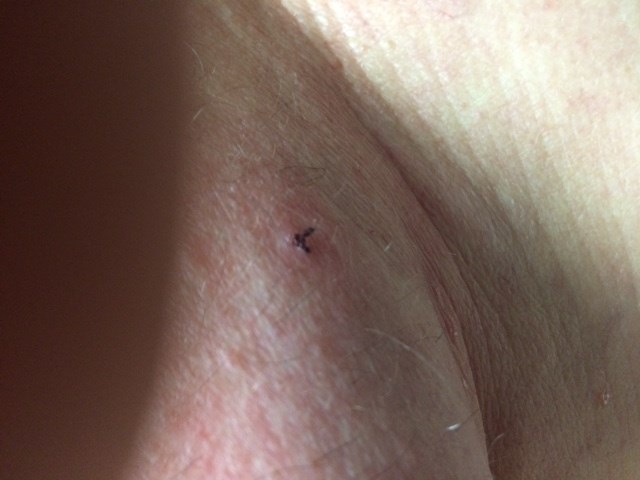Dale Coleman had just returned from Squamish Hospital the day he talked to The Chief.
He was having chest pains and was worried about what it might be, so had gone to the clinic. The doctor there sent him up to the emergency department, Coleman said.
He's OK, but this has been his life since a tick bit him — doctor’s appointments and strange symptoms.

In May 2016, Coleman was at a picnic table at Brennan Park and felt a pinch on his chest.
"I thought I had a sliver of cedar from the picnic table I was sitting on," he said.
"Then I put my hand on my chest and I felt a little tiny bump and so I rubbed it really hard. The bump went away, but I kept feeling this pricking sensation."
When he pulled his hand out there was a spot of blood on his hand and a bit of skin.
He looked under his shirt and could see two little black things sticking out.
He took a picture of it.
Three weeks later, he went to the doctor and took the photo. The doctor didn't think it was likely a blacklegged tick that could carry Lyme disease but sent him home with a two-week antibiotics prescription.
Coleman hadn't had the bullseye rash, which he thought was typical of Lyme disease, so he didn't think too much of it.
Time went by but late in the fall, Coleman started to experience numerous odd symptoms.
"I started to have brain fog and achy joints that would move around from place to place — one day it would be in my hip and the next day it would be in my knee and the next day in my shoulder. In January and February, I started falling down."
While the majority — about 70 or 80 per cent, — of Lyme sufferers get the rash, some don't. Other symptoms, according to the BC Centre for Disease Control include, fever, headache, muscle and joint pains, fatigue and weakness or paralysis of the muscles and face.

A friend suggested it sounded like Coleman had Lyme disease and recommended he see a Lyme-specialist doctor.
About a year after he was bitten, Coleman was seeing a Lyme-literate doctor in Richmond and getting tested for the disease by having his blood sent to the labs in the U.S. and Germany.
Some of the test results he'd had came back negative, while the new ones were positive for the antibodies to B. burgdorferi, the bacterium that is transmitted to humans through the bite of infected ticks.
The BC Centre for Disease Control says in BC, less than one percent of ticks tested carry B. burgdorferi.
Coleman's long, confusing journey to finding out what was wrong is not unique.
According to the Canadian Lyme Disease Foundation, "patients often receive negative test results when the disease is actually present, and false positives are also possible, though less common," reads the foundation's website. "Experienced doctors recommend that Lyme disease be diagnosed clinically, meaning diagnosis is based on an evaluation of your risk and your symptoms."
Jim Wilson, of the Canadian Lyme Disease Foundation, told The Chief the test offered in B.C. is lacking, family doctors aren't always up to date on Lyme and are restricted by outdated guidelines of how to treat the disease.
"We get thousands of calls every year," said Wilson, who currently lives in the Okanagan.
A research study by Vett Lloyd, a Mount Allison University biology professor, and Ralph Hawkins, a clinical associate professor at the University of Calgary's Cumming School of Medicine concluded that up to 95 per cent of Lyme cases were likely going undetected.
Wilson's journey to research Lyme disease started in 1991 when he was bit in Nova Scotia. He was sick for a number of years and coincidentally ended up travelling to Squamish to be treated by the late Dr. LaVerne Kindree, who was considered somewhat of an expert on the disease at the time, Wilson said.
Before he was bitten, Coleman said he never gave Lyme much thought. To this day, since he was bitten, he deals with symptoms he feels are related to Lyme.
He was put on antibiotics for a year after his diagnosis.
"Whenever I would go off them, I would start getting symptomatic again," he said.
Coleman's advice based on his experience is if bitten, people should go to the doctor or the hospital right away and not leave it for three weeks, and see a Lyme-literate doctor.
While ticks are most likely to bite in the spring from March to June, they can be found year-round.
There's a lot of contradictory information about Lyme and Coleman wants it public that it is a complex and confusing condition that is not easy to live with for those who deal with it.
The Squamish Public Library has worked with local advocates to put together a resource library on Lyme.
Got to canlyme.com for other resources and information.
Vancouver Coastal Health was unable to provide anyone for The Chief to speak to for this story.




